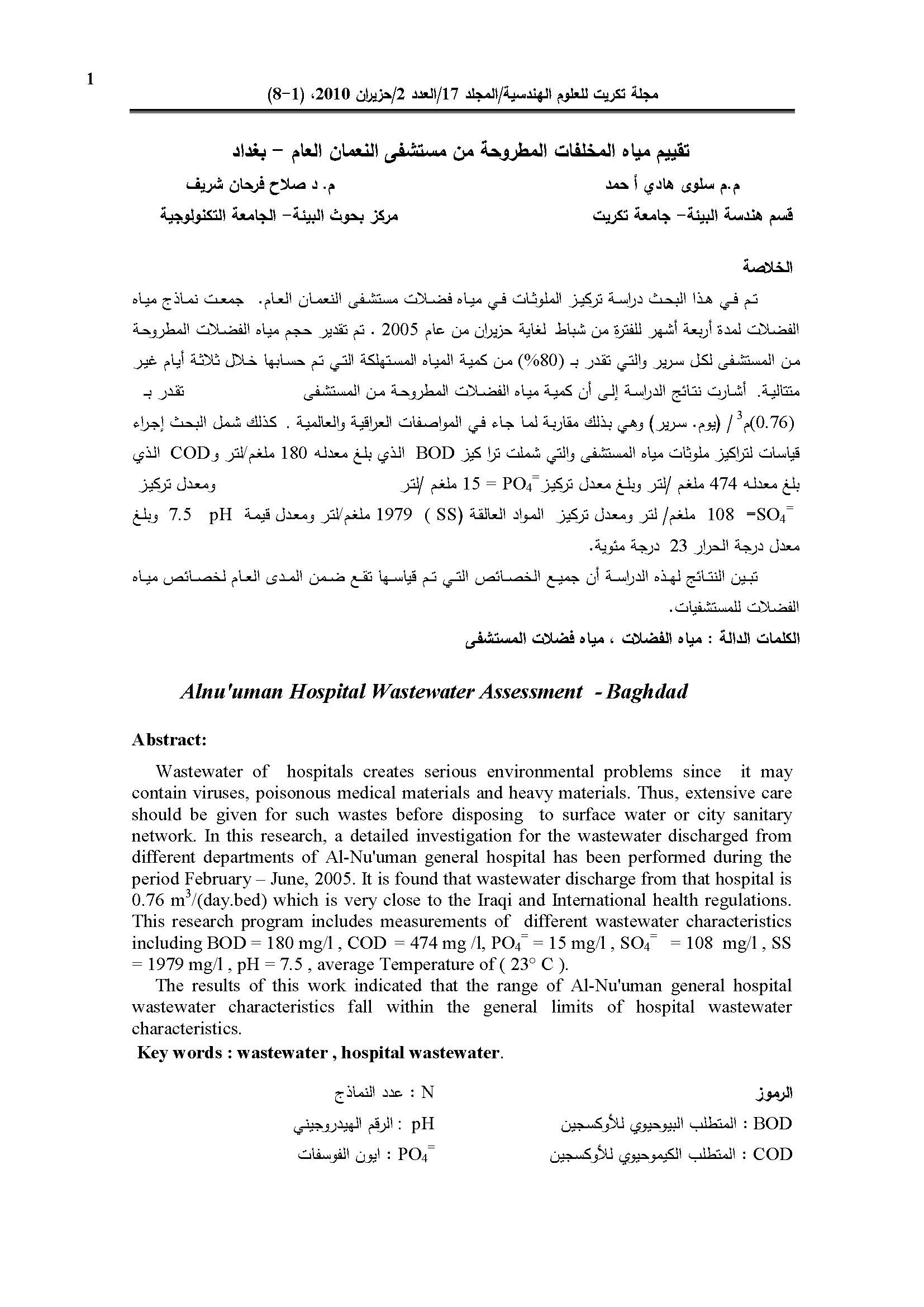Alnu’uman Hospital Wastewater Assessment – Baghdad
Main Article Content
Abstract
Wastewater of hospitals creates serious environmental problems since it may contain viruses, poisonous medical materials and heavy materials. Thus, extensive care should be given for such wastes before disposing to surface water or city sanitary network. In this research, a detailed investigation for the wastewater discharged from different departments of Al-Nu’uman general hospital has been performed during the period February – June, 2005. It is found that wastewater discharge from that hospital is 0.76 m3/(day.bed) which is very close to the Iraqi and International health regulations. This research program includes measurements of different wastewater characteristics including BOD = 180 mg/l , COD = 474 mg /l, PO4= = 15 mg/l , SO4= = 108 mg/l , SS = 1979 mg/l , pH = 7.5 , average Temperature of ( 23° C ). The results of this work indicated that the range of Al-Nu’uman general hospital wastewater characteristics fall within the general limits of hospital wastewater characteristics.
Metrics
Article Details

This work is licensed under a Creative Commons Attribution 4.0 International License.
THIS IS AN OPEN ACCESS ARTICLE UNDER THE CC BY LICENSE http://creativecommons.org/licenses/by/4.0/
Plaudit
References
Environmental Canada (2001) ,”Municipal Wastewater Effluents :What They are and What They Contain”.http:// dsppsd. pwgsc. gc.ca / Collection/EN1-11-96E.pdf.
Pruss,A.; Giroult,E.; Rushbrook, P. (1999),”Safe Management of Wastes from Health-Care Activities “,World Health Organization (WHO), Geneva. http://www.who.int/docstore/water_sanitation_health/wastemanag/begin.htm.
(DDPEA) Division of Pollution Prevention and Environmental Assistance and NC Division of Wastewater Management (Augast,1996), “Waste Reduction and Disposal Options for Specific Hospital Wastes”. http://www.p2pays.org/ref/01/00239.pdf
EPA625/-20/009, Environmental Production Agency (Jun , 1990),”Guides to Pollution Prevention Selected Hospital Waste Stream”. http:// www. cepis. ops_ oms. org/ eswww/ fulltexte/ repind62/gpp.html
Bernet,S.and Fines,M.(2000), “Effluents du CHU de CAEN; Etude Qualitive etQuantitative de la Flore Microbienne et Recherche de Bactéries Multirésistantes “, Quatriéme Journée du Réseau Régional d́Hygiéne de Basse-Normandie.
Leprat,P.(1998),”Les Rejets Liquides Hospitaliers, Quels Agents et Quelles Solutions Techniques?”,Troisiéme Journée du Réseau Régional d´Hygiéne de Basse-Normandie, Caen, Availableon: http://www.pharmacie.unicaenfr/rrh/Documents/resj3/Res2.htm,2 0/09/200
EmmanuelE.;Perrodin,Y.;Keck,G.;Blanchard,JM.;Vermande,P.(2001), “Analyse Statistique des Données Obtenues Pour Quatre Paramétres de Suivi des Effluents Hospitaliers : Utilisation des Chlorures comme Traceurs de leur Ecotoxicité aiguë”.
Mansotte., J. E. (2000),”Les Rejets Liquides des Etablissement de Santé : Caractérisation á la Source et Impact sur l´environnement marin côtier”, Direction Départmentale des Affaires Sanitaires et Sociales de la Seine Maritime, Agence de l´Eau de la Seine Normandie. Synthése et complete sur la base du travail de Florence MERRANT LEBRUN, Centre Hospitalier du Havre, CLIN-Club Environnement, Havre.
Kümmerer, K. ;Meyer, M.;and Steger Hartmann,T.(1997),”Biodegradability of the Anti-Tumor Agent Ifosfamide and its Occurrence in Hospital Effluents and Communal Sewage”,J of water Research. Vol.31,N°. 11,pp.2705-2710. DOI: https://doi.org/10.1016/S0043-1354(97)00121-8
CCLIN Paris-Nord (1999), “Elimination des Effluents Liquides des Etablissements Hospitaliers –Recommandations, “Institut Biomédical des Cordeliers, Paris, 74p.Avalaible on: http://web.ccr.jussieu.fr/guide effluentsliquides. pdf.20/09/201
Stan,H.-J.; and Linkerhager, M.(1994),”Occurrence of Clofibric Acid in Aquatic Systems- Does the Medical Application Cause a Contamination of Surface, Ground and Drinking Water”, Vom Wasser 83,57-68.
Sprehem.,G. S-U; Vogelpohl, A.(1999),”von AOX-Haltigem Abwasser aus dem Krankenhausbereich – Abbau Iodierter Röntgenkontrastittel” ,Technische Universität Clausthal, Institut für Thermische Verfahrenstechnik, Clausthal-Zellerfeld, Korrespondenz Abwasser (46) Nr.4.
Richardson,M.L. and Bowron, J.M.(1985),”The Fate of Pharmaceutical Chemicals in the Aquatic Environment”, J.Pharm.Pharmacol. 37,p.1-12. DOI: https://doi.org/10.1111/j.2042-7158.1985.tb04922.x
Halling-Sorensen ,B.(1998), “Occurrence, Fate and Effects of Pharmaceutical Substances in the Environment –A Review “,Chemosphere, Vol.36,N°2, P.357-393. DOI: https://doi.org/10.1016/S0045-6535(97)00354-8
Gartiser, S. ; Brinker, L.; Erbe, T.; Kümmerer, K. ;and Willmund, R. (1996), “Belastung von Krankenhausabwasser mit Gefährlichen Stoffen im Sinne WHG,”Acta hydrochim. Hydrobio 24,Weinheim. DOI: https://doi.org/10.1002/aheh.19960240206
Montague,P.(1998),”Drug in the Water”, Rachel’s. Environment & Health Weekly # 614 .Environmental Research Foundation, USA, available in:http://www.monitor.net/rachel/r614.html. Email: [email protected]
Bureau of Medicine and Surgery (January,1995),” Wastewater Treatment and Disposal ,Ashore and Afloat “,Manual of Naval Preventive Medicine,
Washnton, D.C.20372-5300,navmed p010-7,0510-lp-209-9600. http://www.nehc.med.navy.mil/downloads/prevmed/NAVMEDP-5010-7.pdf
عباوي , سعاد عبد و حسن , محمد سلمان 1990),”الهندسة العملية للبيئة , فحوصات الماء” دار الكتب للطباعة والنشر, جامعة الموصل.
Qasim,S.R(1985), “Wastewater Treatment Plants :Planning, Designed Operation” , Department of Civil Engineering , The University of Texas at Arlington.





